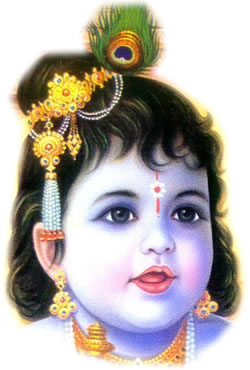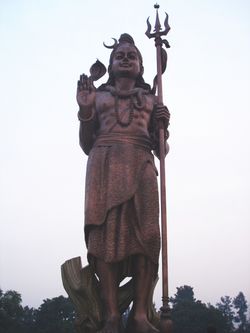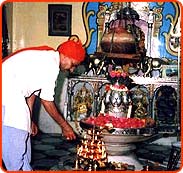

 |
He has gentle as well as fierce forms. Shiva is the greatest of renouncers as well as the ideal lover. He destroys evil and protects good.
He bestows prosperity on worshipers although he is austere. He is omnipresent and resides in everyone as pure consciousness. Shiva is inseparable from Parvati (also referred to as Shakti), who is the daughter of Himavant and Haimavati. There is no Shakti without Shiva and Shakti is his expression; the two are one, the absolute state of being - consciousness and bliss.Shakti in turn is the entire energy of the cosmos. Shiva is said to have shared half of his body for Shakti and is known as Ardhanarishwara (half woman, half man) in this form.In Hinduism, Shiva is said to have taken his form to depict the equality of men and women. The five mantras that constitute Shiva's body are Sadyojaata, Vaamadeva, Aghora, Tatpurusha and Eesaana. Sadyojaata is Shiva realized in his basic reality (as in the element earth, in the sense of smell, in the power of procreation and in the mind). "Eesaana" is Shiva invisible to the human eye. The Vishnudharmottara Purana of the 6th century BC assigns a face and an element to each of the above mantras (Sadyojaata - earth, Vaamadeva - water, Aghora - fire, Tatpurusha - air and Eesaana - space). The names of the deified faces with their elements are Mahadeva (earth), Uma (water), Bhairava (fire), Nandi (air) and Sadasiva (space). Hindu God Lord Shiva the Destroyer Shiva (Sanskrit: Auspicious One), or Siva, is one of the main Deities of Hinduism, worshipped as the paramount lord by the Saivite sects of India. Shiva is one of the most complex gods of India, embodying seemingly contradictory qualities. He is the destroyer and the restorer, the great ascetic and the symbol of sensuality, the benevolent herdsman of souls and the wrathful avenger. Shiva was originally known as Rudra, a minor deity addressed only three times in the Rig Veda. He gained importance after absorbing some of the characteristics of an earlier fertility god and became Shiva, part of the trinity, or trimurti, with Vishnu and Brahma. Click here to see all of our Shiva Statues Lotus Sculpture has for sale The Cult of Shiva Shaivism, or Saivism, is one of the most popular Hindu cults. It embraces many theological practices, although all agree on three principles: pati. or God; pasu, or individual soul; and pasa, or bonds that confine the soul to earthly existence. The aim of Shaivites is to rid their souls of bondage and achieve shivata, the "nature of Shiva". They achieve this through ascetic practices and penances, with an emphasis on yoga and renunciation. Many Shaivites become wandering sadhus, or hold men. Shiavites mark their foreheads with three horizontal marks representing the three aspects of Shiva. Shiva wears a snake coiled around his upper arms and neck symbolizing the power he has over the most deadly of creatures. Snakes are also used to symbolize the Hindu dogma of reincarnation. Their natural process of molting or shedding their skin is symbolic of the human souls transmigration of bodies from one life to another. Thiruvalangadu, north of Madras, is associated with the dance contest between Shiva and his consort in the form of Kali. According to legend, Shiva danced vigorously, and to subdue Kali, threw up his leg in the rhythm of the dance. Being a lady, Kali could not repeat this feat and stood dismayed. This dance and the subjugation of Kali, are described in the hymns of the female saint-poet Karaikkal Ammai. Shiva's female consort and wife is Parvati; because of his generosity and reverence towards Parvati, Shiva is considered an ideal role model for a husband. The divine couple together with their sons - the six-headed Skanda and the elephant headed Shiva - reside on Mount Kailasa in the Himalayas. Click here to see all of our Shiva Statues Lotus Sculpture has for sale He often holds a trident, which represents the Hindu trinity of Brahma, Shiva and Vishnu. It is also said to represent the threefold qualities of nature: creation, preservation and destruction, although preservation is usually attributed to Vishnu. As the destroyer Shiva is dark and terrible, encircled with serpents and a crown of skulls. In the pictures to the right and left Shiva wears sacred Rudraksha beads, perhaps a reference to his earlier name Rudra. The crescent moon Shiva wears on his crown, besides being a symbol of Kama the goddess of nightly love, also represents the bull, Nandi, a fertility symbol. Shiva holds a skull that represents samsara, the cycle of life, death and rebirth. Samsara is a central belief in Hinduism. Shiva himself also represents this complete cycle because he is Mahakala the Lord of Time, destroying and creating all things. His guardian is Nandi (the white bull), whose statue can often be seen watching over the main shrine. The bull is said to embody sexual energy, fertility. Riding on its back, Shiva is in control of these impulses. Click here to see all of our Shiva Statues Lotus Sculpture has for sale Shiva is represented in a variety of forms. One such form is as a lingam. The ovoid shape is a representation of the absolute perfection of Lord Shiva - if that which is beyond form had to be given form, the lingam would be the closest form to the mystical experience of the absolute perfection of Shiva. The Story of the Shiva Lingam: Shiva saw not sense in the transitory pleasures of life, so he rejected samsara, smeared his body with ash, closed his eyes and performed austerities. Shiva's tapas generated so much heat that his body transformed into a pillar of fire - a blazing lingam that threatened to destroy the whole world. The gods did not know how to control Shiva's fire. Suddenly there appeared a yoni - the divine vessel of the mother-goddess. It caught the fiery lingam and contained its heat, thus saving the cosmos from untimely destruction. Shiva is often pictured in a pacific mood with his consort Parvati, as the cosmic dancer Nataraja, as a naked ascetic, as a mendicant beggar, as a yogi Dhakshinamurthy, and as the androgynous union of Shiva and Parvati in one body (Ardhanarisvara). Click here to see all of our Shiva Statues Lotus Sculpture has for sale Shiva also takes the form of Ardhanari, his androgynous form. The right side of the sculpture is Shiva and the left side is Parvati. The attributes of each are split directly down the middle. Another example of Shiva's apparent synthesis of male and female attributes is seen in his earrings. He wears one earring in the style of a man and the other as a female as shown in the two different earrings Shiva wears. In the picture to the left you can clearly see Shiva's third eye. The third eye is a symbol of higher consciousness. It is also something with which he can destroy his enemies "with fire." He can also kill all the gods and other creatures during the periodic destruction of the universe. Shiva's third eye first appeared when Parvati, his wife, playfully covered his other two eyes, therefore plunging the world into darkness and putting it in danger of destruction. Click here to see all of our Shiva Statues Lotus Sculpture has for sale click here to view a full list of categories Sign up for email updates: home | about us | bronze casting | hindu gods | contact us | lotus articles | shipping and policies | international orders © 2003-2005 Lotus Sculpture Shiva, Shiva The Destroyer, Hindu God Shiva, Lord Shiva new arrivalsbronzemarblewoodthe godsgarden statuesmasterpiecesspecialssouth indian bronzebengali bronzethai brassabout bronze castingred marbleblack marblewhite marblegray marblehindu temple carvingsbuddhist wood sculpturebuddhashivaganeshvishnulakshmiparvatikrishnanatarajasaraswatidevishaktihanumankali and durgamuruganother godsabout the godscustom sculpturegranite sculpturegarden buddhassmall statues (1'-4')large statues (4'-8')bronze creativedharma sculpture A statue of Shiva near Indira Gandhi International Airport, DelhiIn Shiva temples, Parvati, Navagraha (9 planets), Ganesh, Skanda, Saraswati, Lakshmi, Vishnu, Brahma, Ashtathig balar, Durga, Bhairava, and all the other Hindu gods will have the place, denoting that Shiva is unique among the gods, so that only he is in a shapeless form (i.e. in linga form). The five different avataras (forms) of Shiva are Bhairava ???? Nataraja ????? Dakshinamurthy ?????????????? Somaskandha ????????? Pitkchadanar ??????????? In most of the South Indian temples, we can see all the five forms in a Shiva temple. All the five characteristics in a single face is said to be Sadashiva. Shiva is not limited to the personal characteristics as he is given in many images and can transcend all attributes. Hence, Shiva is often worshipped in an abstract manner, as God without form, in the form of linga. This view is similar in some ways to the view of God in Semitic religions such as Islam or Judaism, which hold that God has no personal characteristics. Hindus, on the other hand, believe that God can transcend all personal characteristics and yet have personal characteristics for the grace of the embodied human devotee. Personal characteristics are a way for the devotee to focus on God. Shiva is also described as Anaadi (without beginning/birth) and Ananta (without end/death). The tale about Shiva splitting into two halves of male and female indicates the origin of the Ardhanarishvara - the union of spirit and material, the Being and his Shakti (force). He is also above Spirit and Material. According to a school of Kashmir Shaivism entited Spanda, the central role for a human devotee is not played by Siva but by Shakti. This is not paradoxical because in the spiritual vision of Shaivism, Siva and Sakti are not two separate realities. Siva and Sakti are two-in-one, and they seem separate only for the ignorant and limited mind that is subjected to duality. In truth, Siva is Sakti and Sakti is Siva; when we have consciousness, there is also energy. When we have energy, there is consciousness who animates that energy. Therefore, for the aspirant to spiritual liberation, the instrument (path) is Sakti and not Siva. Siva is the transcendent aspect of the Divine, being beyond any mental representation. Anything we could imagine about Siva is not Siva, because Siva cannot be defined, cannot be thought, cannot be evoked. [edit] Shiva: Supreme God Shiva is the supreme God of Shaivism, one of the four main branches of Hinduism practiced in India today (the others being Vaishnavism, Shaktism, and Smartism.) His abode is called Kailasa, a mountain in south Tibet. His holy Vahana (Sanskrit for transport) is Nandi, the Bull. His attendant is named Bhadra. Shiva is usually represented by the Shiva linga. In images, he is generally represented as immersed in deep meditation on Mount Kailash (reputed to be the same as the Mount Kailash in the south of Tibet, near the Manasarovar Lake) in the Himalayas, his traditional abode). 108 shiva lingas carved on the rock at the banks of river Tungabhadra, HampiShiva is the God of all and is worshipped by all, from Devas (gods) such as Brahma, Indra, by Asuras(demons) like Bana, Ravana, by humans like Adi Shankara, Nayanars, by creatures such as Jatayu, an eagle, Vali, an ape, and the list goes on and on. Furthermore, the site states that people of different backgrounds and qualities worship the Shiva, with many temples having histories of even cranes, bees, elephants, (see Kalahasti), spiders, snakes, worshipping Shiva and getting blessed. It concludes that the Lord, as the Supreme one, blesses anyone who worships him in sincere devotion as there is no discrimination on who the seeker is. Although Lord Shiva loves His devotees equally as He does not ignore the tapasya of rakshasas, asuras or anybody, even those with bad intentions, He always finds ways to protect dharma and not allow anybody evil to triumph over good. Major deities, rishis, planets, worshipped Shiva and established Shivalingas in various places in India. Somnath located at Prabhas Patan in Saurashtra in Gujarat. Dwarka in Gujarat is home to the Nageshwar Jyotirlinga temple. Mahakal, Ujjain (or Avanti) in Madhya Pradesh is home to the Mahakaleshwar Jyotirlinga temple. Srisailam - Srisailam near Kurnool enshrines Mallikarjuna in an ancient temple architecturally and sculpturally rich. Bhimashankar, in the Sahyadri range of Maharashtra, contains a Jyotirlinga shrine associated with Shiva destroying the demon Tripurasura.
 Omkareshwar in Madhya Pradesh is an island in the Narmada river, home to a Jyotirlinga shrine and the Amareshwar temple. Sukreswar Temple located on Sukreswar hill in Guwahati on the southern bank of Brahmaputra, with the ghat leading down to the river. Uma Nanda Temple located on the Peacock island in middle of River Brahmaputra in Guwahati. Kedarnath in Uttaranchal is the northernmost of the Jyotirlingas. Varanasi (Benares) in Uttar Pradesh is home to the Vishwanath Jyotirling temple. Trimbakeshwar, near Nashik in Maharashtra, has a Jyotirlinga shrine located associated with the origin of the Godavari river. Grishneshwar Jyotirlinga shrine, in Maharashtra, is located near the rock-cut temples of Ellora. Deoghar, in the Santhal Parganas region of Jharkhand, is home to the Vaidyanath Jyotirlinga temple. Ganesh worshipped Shiva at Pillayar patti (100 km from Madurai, India) The four Vedas worshipped Shiva at Thirumaraikaadu (i.e., Vedaaranyam near Tanjore) Skanda worshipped Shiva at Thiruchendur (200 km from Madurai, India) Rama (avatar of Vishnu) worshipped Shiva in Rameswaram(India) Vishnu worshipped Shiva atKanchipuram (Kachiswarar Temple) Parasurama (avatar of Vishnu) worshipped Shiva at Sreesailam, Karnataka and also at Chennai (Parasurama at Lingeshwara Temple, Iyanavaram) Goddess Lakshmi (wife of Vishnu) worshipped Shiva at Tirupachethi (50 km from Madurai). Surya worshipped Shiva at Srivilliputhur (Vaidhyanathaar Temple 100 km from Madurai) Brahma and Vishnu at Tiruvannamalai (180 km from Chennai) Brahma at Vrinchipuram (155 km from Chennai, 15 km from Vellore) Raagu and Kethu at Kaalahasthi (50 km from Tirupathi, Andhra Pradesh, India) Indra at Madurai (Soma Sundareeswar Temple) The Rishi Agastya at Papanasam (100 km from Tirunelveli, Tamil Nadu, India) Goddess Parvati at Kancheepuram (Ekambeeswarar Temple, 70 km from Chennai, India) Shani at Thirnallar (near Kaaraikal, Pondicherry) Moongod at Thingalur (near Tanjore) Shiva and Sani at Thirvidaimaruthoor (near Kumbakonam) Brahma at Kumbakoonam (Kumbeeswarar, near Tanjore) Ujjain Jyotirlinga shrine, in Madhya Pradesh. Lord Shiva at Trilochan , is famous with name of Trilochan Mhadev Temple , 30 km from varanasi , india Shiva (English IPA: [??v?], [?i?v?] Sanskrit: ???; Hindi: ???; Malayalam ??????; Tamil: ????? (when used to distinguish lordly status), also known as Siva and written Siva in the official IAST transliteration, pronounced as /?i??/) is a form of Ishvara or God in the later Vedic scriptures of Hinduism. Shiva is the supreme God in Shaivism, one of the major branches of Hinduism practiced in India. He is the formless, timeless and spaceless Supreme God in Shaivism. Adi Sankara interprets the name Shiva meaning "One who purifies everyone by the utterance of His name" or the Pure One. The name Shiva is the Holiest of Holy names. The Good Lord is beyond and unaffected by the three gunas (characteristics) of Prakrti (matter/nature) namely Satva, Rajas, and Tamas. In Smarta traditions, Shiva is one of the the three aspects of God or Trimurti,(not to be compared to the trinity as in Christianity). In the Trimurti, Shiva is the destroyer, and Brahma is the creator and Vishnu is the preserver. Shiva, in Shaivism, does everything. All other hindu gods and goddess are lesser than Shiva in this view. According to Shaivism, the Good Lord Shiva performs five functions: 1. Creator, 2. Preserver, 3. Destroyer of evil, 4. Reprieving us from the sins, and most importantly, 5. Blessing. A Shaivite view contends that Shiva produces Vishnu who produces Brahma and thus creation began, within which the cycle of the Trimurti exists. Shiva also assumes many other roles, including the Lord of Ascetics (Mahadeva, or the Great God), the Lord of Boons (Rudra, or The Howler - rud-iti rudra), and also the Universal Divinity (Maheshvara, the Great Lord).Shaivaites, the worshippers of Shiva consider as the Ultimate Reality (see Ishta-Deva for fuller discussion). Shiva is usually represented by the Shiva linga (or lingam), usually depicted as a clay mound with three horizontal stripes on it, or visualised as a blazing pillar. In anthropomorphised images, he is generally represented as immersed in deep meditation on Mount Kailash, his traditional abode Omkareshwar in Madhya Pradesh is an island in the Narmada river, home to a Jyotirlinga shrine and the Amareshwar temple. Sukreswar Temple located on Sukreswar hill in Guwahati on the southern bank of Brahmaputra, with the ghat leading down to the river. Uma Nanda Temple located on the Peacock island in middle of River Brahmaputra in Guwahati. Kedarnath in Uttaranchal is the northernmost of the Jyotirlingas. Varanasi (Benares) in Uttar Pradesh is home to the Vishwanath Jyotirling temple. Trimbakeshwar, near Nashik in Maharashtra, has a Jyotirlinga shrine located associated with the origin of the Godavari river. Grishneshwar Jyotirlinga shrine, in Maharashtra, is located near the rock-cut temples of Ellora. Deoghar, in the Santhal Parganas region of Jharkhand, is home to the Vaidyanath Jyotirlinga temple. Ganesh worshipped Shiva at Pillayar patti (100 km from Madurai, India) The four Vedas worshipped Shiva at Thirumaraikaadu (i.e., Vedaaranyam near Tanjore) Skanda worshipped Shiva at Thiruchendur (200 km from Madurai, India) Rama (avatar of Vishnu) worshipped Shiva in Rameswaram(India) Vishnu worshipped Shiva atKanchipuram (Kachiswarar Temple) Parasurama (avatar of Vishnu) worshipped Shiva at Sreesailam, Karnataka and also at Chennai (Parasurama at Lingeshwara Temple, Iyanavaram) Goddess Lakshmi (wife of Vishnu) worshipped Shiva at Tirupachethi (50 km from Madurai). Surya worshipped Shiva at Srivilliputhur (Vaidhyanathaar Temple 100 km from Madurai) Brahma and Vishnu at Tiruvannamalai (180 km from Chennai) Brahma at Vrinchipuram (155 km from Chennai, 15 km from Vellore) Raagu and Kethu at Kaalahasthi (50 km from Tirupathi, Andhra Pradesh, India) Indra at Madurai (Soma Sundareeswar Temple) The Rishi Agastya at Papanasam (100 km from Tirunelveli, Tamil Nadu, India) Goddess Parvati at Kancheepuram (Ekambeeswarar Temple, 70 km from Chennai, India) Shani at Thirnallar (near Kaaraikal, Pondicherry) Moongod at Thingalur (near Tanjore) Shiva and Sani at Thirvidaimaruthoor (near Kumbakonam) Brahma at Kumbakoonam (Kumbeeswarar, near Tanjore) Ujjain Jyotirlinga shrine, in Madhya Pradesh. Lord Shiva at Trilochan , is famous with name of Trilochan Mhadev Temple , 30 km from varanasi , india Shiva (English IPA: [??v?], [?i?v?] Sanskrit: ???; Hindi: ???; Malayalam ??????; Tamil: ????? (when used to distinguish lordly status), also known as Siva and written Siva in the official IAST transliteration, pronounced as /?i??/) is a form of Ishvara or God in the later Vedic scriptures of Hinduism. Shiva is the supreme God in Shaivism, one of the major branches of Hinduism practiced in India. He is the formless, timeless and spaceless Supreme God in Shaivism. Adi Sankara interprets the name Shiva meaning "One who purifies everyone by the utterance of His name" or the Pure One. The name Shiva is the Holiest of Holy names. The Good Lord is beyond and unaffected by the three gunas (characteristics) of Prakrti (matter/nature) namely Satva, Rajas, and Tamas. In Smarta traditions, Shiva is one of the the three aspects of God or Trimurti,(not to be compared to the trinity as in Christianity). In the Trimurti, Shiva is the destroyer, and Brahma is the creator and Vishnu is the preserver. Shiva, in Shaivism, does everything. All other hindu gods and goddess are lesser than Shiva in this view. According to Shaivism, the Good Lord Shiva performs five functions: 1. Creator, 2. Preserver, 3. Destroyer of evil, 4. Reprieving us from the sins, and most importantly, 5. Blessing. A Shaivite view contends that Shiva produces Vishnu who produces Brahma and thus creation began, within which the cycle of the Trimurti exists. Shiva also assumes many other roles, including the Lord of Ascetics (Mahadeva, or the Great God), the Lord of Boons (Rudra, or The Howler - rud-iti rudra), and also the Universal Divinity (Maheshvara, the Great Lord).Shaivaites, the worshippers of Shiva consider as the Ultimate Reality (see Ishta-Deva for fuller discussion). Shiva is usually represented by the Shiva linga (or lingam), usually depicted as a clay mound with three horizontal stripes on it, or visualised as a blazing pillar. In anthropomorphised images, he is generally represented as immersed in deep meditation on Mount Kailash, his traditional abode |

 |
 |













